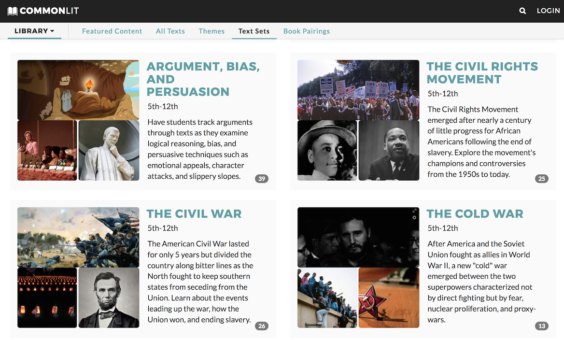4 Creative Ways to Use Nonfiction Text Sets
With the rise of the Common Core – and the increased focus on an expanded literacy that supports academic reading and writing, civics education and “close reading the media” – access to high-quality, freely available nonfiction texts is a big plus for teachers.
If you haven’t heard about CommonLit, it’s high time! We’ve invited Rob Fleisher, the nonprofit’s director of school partnerships and a former District of Columbia teacher, to share some creative ideas about using this valuable resource.
Simply put, CommonLit is a free reading and writing program for grades 3-12 that helps engage students and expand units with supplemental texts.
When CommonLit was first featured on MiddleWeb in the winter of 2015, our work was in its very early stages. At the time, we had fewer than 100 lessons on our site and the only option teachers had was to download our lessons as PDFs.
Since then, our digital library and tools have grown rapidly. We currently have over 900 multi-subject lessons addressing a variety of topics, genres, and themes. Best of all, when teachers come to CommonLit, they can create online classes, provide students with digital supports, and measure student progress using our online data tracking tools.
While CommonLit is unique in that it offers authentic texts from a variety of famous authors — including Amy Tan, Gary Soto, Robert Frost, and Langston Hughes — we also offer a rich variety of Nonfiction Text Sets. These text sets are groups of 5-20 individual texts that share a common topic.
Currently, we have 33 of these text sets with topics ranging from Ancient Egypt to The Cold War to Psychology and the Mind. And just like our other lesson plans, these lessons are and always will be free.
In this post, I’ll explain a few best practices for using our nonfiction text sets to purposefully drive student achievement in English, social studies, and science classrooms.
Promoting Research and Writing
Teachers can use CommonLit for an extended research unit on a topic such as The Civil Rights Movement. In a research unit, students read extensively on a single topic and then form a conclusion based upon the expertise they have gained. Our text set on the Civil Rights Movement, which includes 16 different texts (and counting) can be assigned to students strategically, or as a complete set. Below are just a few examples of writing prompts that teachers can use to drive the research unit:
- Throughout the 1950s and 1960s, how was non-violent protest used to promote the goal of racial equality?
- What role did the court play in the Civil Rights Movement?
- What changes were made to America’s laws during the Civil Rights Movement? How did these changes affect the lives of African Americans?

Argumentation and Debate
CommonLit’s text sets can also be used to practice argumentative writing, which is a cornerstone of college-readiness. Argumentative prompts require that students read widely about a single debatable topic and pick a side to defend. Students must compose an original claim and support that claim with concrete examples from the various texts they’ve read. The final product of an argumentative unit could be a longer essay and participation in an oral class debate or discussion.

Below are a few examples of argumentative writing prompts that teachers could assign to students based upon CommonLit’s American Civil War text set:
- Was the result of the Civil War ever truly in question? In other words, was there any way that the South could have been victorious?
- Was the Civil War avoidable? Was there any way that leaders could have prevented confrontation?
Learning Vocabulary
Texts sets are a great way for students to learn vocabulary. Within each CommonLit text set, teachers will find domain-specific vocabulary words and concepts that appear continuously throughout the texts on that given topic.
Through frequent exposure to these words, students will be much more likely to retain the definition and use them in writing and speech.
For example, here are just a few domain-specific words that are repeated within our Modern Democracy in America text set:
- “bill” – 2 times
- “election” – 3 times
- “right” – 3 times
- “Supreme Court” – 4 times
- “legislate” or “legislator” – 3 times
- “democracy” – 3 times
“Washington Capitol Hill” by Arend (CC BY 2.0)
Differentiation and Reading Ladders
Text sets also make it extremely easy for teachers to differentiate instruction while still keeping students in the same class learning about the same topic. Using the CommonLit digital platform, teachers can assign different texts on the same topic to different students based on their ability level.
Let’s use the Native American History text set as an example:
- If a teacher wants her students to understand Native American removal, she could assign “Excerpts from Trail of Tears Diary” (1000L, 5th-6th grade) to struggling students and “Andrew Jackson’s Speech to Congress on ‘Indian Removal’” (1390L, 9th-10th grade) to more advanced readers.
- For a teacher who wants their students to learn about the history of Native American boarding schools, “Those Kids Never Got to Go Home” (1060 L, 9th-10th grade) may be appropriate for some students whereas “How Native Students Can Succeed In College: ‘Be As Tough As The Land That Made You’” (940L, 7th-8th grade) may be better for students on a slightly lower reading level.

Another slightly different option is to use something called “reading ladders,” a term popularized by Teri S. Lesesne. A reading ladder is a series of texts, often on the same topic or within the same genre, that become progressively more challenging. Students can move to the next text once they show mastery on the lower level text. This is a great way to help students gain a sense of confidence as they experience “productive struggle” with complex texts.
Using CommonLit’s Native American History text set, students may begin with a text like “Red Cloud’s Speech After Wounded Knee” (950L, 7th-8th grade) and then move to a somewhat harder text like “From Resistance to Reservations” (1080L, 9th-10th) since the two address very similar topics. More advanced students can move quickly into texts that meet them where they are.
Regardless of what strategies you choose, we hope that you learn to love our nonfiction text sets. If you try any of these ideas in your classroom, or come up with original strategies of your own, we want to hear how it went. Let us know in the comments below!
Rob Fleisher taught for six years in Washington, DC as a Special Educator. He is now CommonLit’s Director of School Partnerships and works with districts to help them successfully implement CommonLit’s free literacy program. Contact Rob via info@commonlit.org.






































